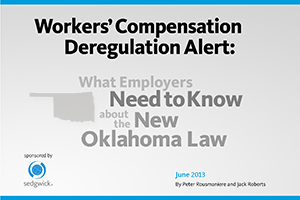
The country generally views California as the state where change in fashion or law happens first. Not so with the new Oklahoma workers' compensation alternate coverage law. Sedgwick released a white paper on June 4th highlighting the legislation, authored by Peter Rousmaniere and Jack Roberts of the New Street Group who say this may be "the most inventive" workers' compensation legislation of any state since the early decades of the 20th century.
Oklahoma joins Texas as the only other state to allow employers the ability to offer an alternate coverage plan, replacing the statutory workers' compensation system. This may not resonate on quite the same level as a Red River Rivalry Sooner football victory, but it does give Oklahoma a leg up in legislative action.
Here are my eight key highlights to the bill. I encourage you to read Sedgwick's white paper for in-depth coverage.
- If everything stands, February 1, 2014 will be the first day for employers to act. Any employer who wishes to provide an alternate workers' compensation option can apply to the commission and be deemed a "qualified employer."
- Employees must be notified that their employer is no longer carrying workers' compensation coverage and has established an alternative benefits plan; they must also be given the contact information of the employer's designated contact as well as that of the administrator.
- Qualified employers may self-fund or insure benefits payable under the plan and provide satisfactory proof to the commissioner as to their financial ability to pay compensation.
- The alternate plan can be ERISA-based, but must provide for payment of the same forms of benefits included in the administrative workers' compensation act. This includes temporary total and partial disability, permanent total and partial disability, vocational rehabilitation, disfigurement, amputation, death and medical benefits on a no-fault basis with the same statute of limitations and with dollar, percentage and duration limits that are at least equal to or greater than those of the current law.
- Unlike the Texas non-subscription opt-out, employers who wish to provide an alternative benefits plan will still enjoy exclusive remedy.
- The benefits plan may provide for lump sum payouts in the form of voluntary settlement agreements as soon as ten days post-injury, given the employee was seen by a non-emergency physician.
- Options for medical management can be customized by the employer.
- No current state provision for penalties shall apply to a qualified employer under its alternative benefits plan.
Oklahoma still needs to construct rules around the process and the bill will be reviewed by the Oklahoma Supreme Court to confirm specific sections meet constitutional guidelines, but Sedgwick is encouraged by the potential benefits this new law could bring for both employers and injured workers.
Do you think the new Oklahoma law will provide better alternatives to employers in the state? Could this legislation prompt other states to consider alternative options?
Eddy Canavan, Director National Technical Compliance